031 - The Regeneration of Aspen Stands in Southern Utah
Background
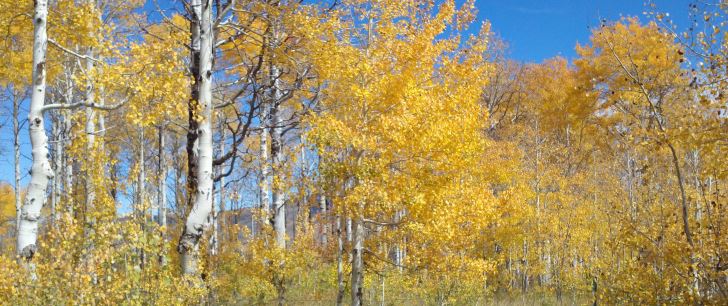
Multiple age-classes of quaking aspen on Cedar Mountain, Utah. Photo courtesy of Justin Britton.
Quaking aspen (Populus tremuloides) is an important species in southern Utah and across western landscapes. Aspen serves as the primary deciduous tree species in many western landscapes, providing unique habitat for various animals and plants. It serves as an important resource for wildlife and can act as a firebreak around developed areas. Aspen’s cool, lush understories and beautiful fall colors result in structural and aesthetic characteristics desired by many landowners and recreationists. These qualities make aspen a valuable species to protect, especially in light of recent concerns regarding the decline of this species in areas across the West. This decline, termed sudden aspen decline or ‘SAD’, has motivated the investigation of management strategies to effectively regenerate aspen stands. One such example is the creation of the Guidelines for aspen restoration produced by the Utah Forest Restoration Working Group in 2010. This factsheet is based on a study in southwestern Utah to determine what type of silvicultural strategies and techniques were most likely to result in aspen regeneration. Based on the results of this research, we provide landowners and managers with a simple and effective tool for regenerating aspen stands.
The Process
Regenerating Aspen
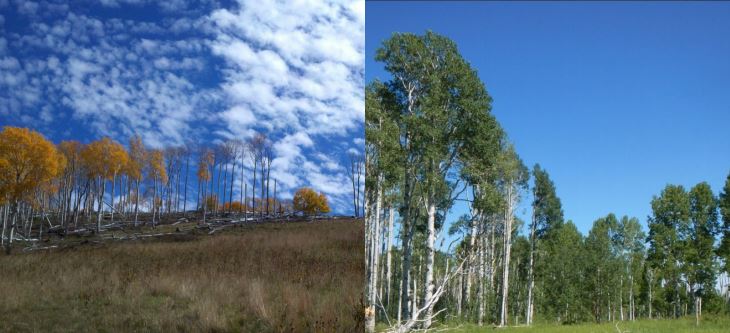
Figure 1. Stands in poor condition (left) are less likely to express a vigorous response to treatment than healthy stands (right). Stands in poor condition have dying overstory trees, open sparse foliage in the crowns, and a lack of young stems, whereas stands in good condition have substantial leaf area, limited mortality, understory aspen, and could also have multiple cohorts (heights) of aspen stems. Photo courtesy of Justin Britton.

Figure 2. A strong component of advance reproduction prior to overstory removal (left) is an excellent predictor of the response of suckers to treatment (right). Monitoring for the presence of advance reproduction is recommended prior to conducting overstory removal. Photo courtesy of Justin Britton.
Simple coppice silviculture, or cutting the stems to encourage new growth, is the traditional means by which managers regenerate aspen in the Intermountain West. This management technique relies on reproduction via suckers originating from the parent root system. There are additional options for promoting this suckering response such as prescribed fire, mechanical root stimulation, and the removal of vegetative competition. These management options have recently been expanded to account for potential seeding events. More can be read about these techniques in the paper by Long and Mock (2012) listed in the resources section at the end of this factsheet.
Scientific Basis
We investigated recent aspen regeneration treatments in order to identify factors influencing aspen regeneration and recruitment in southern Utah. We measured over 100 plot-pairs, located in areas that had been recently treated for aspen regeneration. There were four types of treatments: prescribed fire; conifer removal; removal of dead and dying overstory; and the removal of trees forming the upper canopy of the forest, known as overstory removal. Four types of site preparation methods were conducted: broadcast burning; pile and burn; domestic animal exclusion; or no site preparation at all. In addition to the type of overstory removal, the type of site preparation was an important driver in the quantity of regenerating aspen stems. Using robust statistical methods, we successfully reduced a large number of factors that might influence aspen regeneration down to just a few.
Application
Here we describe these important factors in detail and explain how to monitor and make management decisions about an aspen stand. By better understanding the influence of these primary factors on aspen, we can recommend practical and effective aspen management strategies. Following this discussion, we describe how the factors were incorporated into a useful Aspen Regeneration Decision Pyramid which can be consulted prior to making decisions about how to regenerate an aspen stand.
Important Factors That Influence Aspen Regeneration
Four primary factors should be taken into consideration in order to increase the chances of aspen regeneration success:
- current stand condition
- presence of advance reproduction
- site preparation
- browsing pressure or herbivory
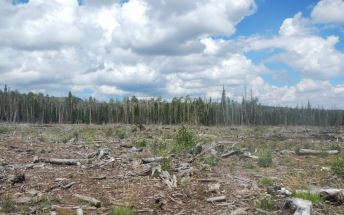
Figure 3. Site preparation can have a dramatic influence on the quantity of aspen suckers post-treatment. These stands are adjacent to each other on the landscape and overstory removal was conducted over two years, (top) was subject to pile-and-burn, and (bottom) was broadcast burn. Photo courtesy of Justin Britton.
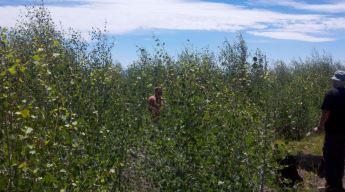
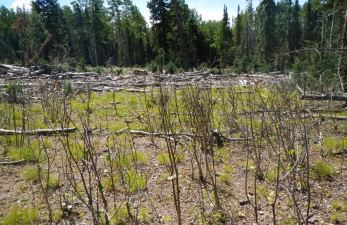
Figure 4. In this post-treatment stand, aspen suckers were plentiful and are on average 3 feet tall. Unfortunately, virtually every regenerated aspen had been browsed, which represents intense herbivory. If browsing this intense was encountered prior to treatment, recommendations to reduce browsing intensity should be followed. Photo courtesy of Justin Britton.
Current Stand Condition
Starting with a healthy aspen stand is always a benefit when considering management options. A well-stocked stand with at least 250 trees per acre with vigorous, full, green crowns will increase the chances of successful regeneration (Fig. 1).
Presence of Advance Reproduction
Advance reproduction is defined as any aspen that exists beneath the canopy, or in the understory of a mature stand. The more advance reproduction in a stand, the better the chances of regeneration success (Fig. 2). Advance reproduction is an indicator of stand vigor and potential for regeneration. If the advance reproduction present in an aspen stand is short, shrubby, or consists mostly of large diameter trees, this may be an indicator of excessive browse. These characteristics can increase the risk of regeneration failure. Take caution in managing an aspen stand due the risks associated with herbivory.
Preparing a Site for Successful Regeneration
Site preparation is defined as management that occurs after the overstory removal with the intent to improve site conditions for desired species (Fig. 3). Stark differences in regeneration response can result from the site preparation method. Our study results suggested that both broadcast burning (controlled application of a low-intensity surface fire) and domestic animal relief (restricting domestic animals from the area with fencing or other methods) were the best techniques for improving the number of stems regenerating in the stand. Broadcast burning is the controlled application of a low-intensity surface fire. Piling and burning was a less productive site preparation technique than broadcast burning. Domestic animal relief is most effective when livestock are removed from a site until the regeneration has reached heights above ~ 6 feet. This may take up to three growing seasons.
Browsing Pressure
Browsing pressure on aspen has long been a concern in aspen management. The results of our study identified herbivory to be the leading cause of regeneration failure (Fig. 4). This finding highlights the importance of monitoring and protecting regeneration within management units. The condition of understory aspen stems can be easily monitored for the presence of browsing by counting the number of stems in a small radius with and without browsed terminal buds. If there are no understory aspen stems on which to conduct an assessment of herbivory, consider fencing off a small area of the stand for several years in order to determine if browsing is an explanation for the lack of advance reproduction. Another reason for limited understory aspen could be low stand vigor.
Aspen Regeneration Decision Pyramid
We have incorporated our findings into an aspen regeneration management pyramid that summarizes the information above. This guide is organized according to the importance of each factor relative to its influence on aspen regeneration. Use this guide to aid in the decisionmaking process prior to treatment. The Aspen Regeneration Decision Pyramid (Fig. 4) can be used in the field for quick and easy assessment of the condition of the aspen stand prior to making treatment decisions.
Using the Pyramid — An Example
Consider the following hypothetical example of an aspen stand being evaluated for treatment. The stand has approximately 400 stems per acre, is 150 years old, and has moderately healthy looking crowns. The amount of advance reproduction is minor with only a few stems in a radius of about 20 feet. However, half of those stems have evidence of browsing on the terminal bud. The landowner is considering following up the overstory harvest with a broadcast burn. We use this information to answer the questions in the pyramid below, working from the top to the bottom and determine the associated risk of failure of regeneration within the stand. Our results indicate a score of eight, which suggest moderate to low risk of regeneration failure. To further minimize the risk, management options include: waiting or delayed overstory removal, partial overstory removal, or; making canopy gaps, after which regeneration response could be assessed. Such canopy gaps of 15-25 ft. in diameter have been successful at stimulating growth. Other options include fencing, which can be very expensive. Furthermore, if the landowner is part of a collective group that manages domestic animals, fencing may not be an option on certain grazing allotments and/or grazing collective situations. In situations such as these, alternatives to grazing and fencing, i.e. rest and rotation, might be needed to allow the young aspen to reach six feet in height and escape the risk of herbivory.
There are a number of situations where the landowner should be conservative in stand treatment tactics, such as when there is evidence of browsing, poor stand condition, and limited advance reproduction. In these particular cases, we make explicit recommendations below to help mitigate these conditions:

- Site Preparation: Consider postponing management until effective site preparation techniques may be employed. Local state foresters may be able to assist with the implementation of site preparation. In Utah, contact the Division of Forestry, Fire, and State Lands to find a forester than can help.
- Advance Reproduction: If stands are lacking advance reproduction, consider techniques known to stimulate sucker production. This may include broadcast burning prior to harvest or even making small (15-25 ft. diameter) canopy gaps that will increase the amount of sunlight reaching the forest floor. Such gaps will encourage aspen regeneration. Root ripping may also be an option. This generally involves using a tractor to create a temporary, narrow trench around the outside of a stand. When applied to a vigorous stand this disturbance will result in root suckering, or sending up young trees.
- Stand Condition: Unfortunately, there are few options for improving stand condition. Consider the installation of protective fencing as the exclusion of grazing animals may improve stand condition over time. Alternatively, landowners may consider thinning their aspen stand to reduce density and improve the growth of the remaining trees.
Regardless of results from the pyramid, posttreatment monitoring should always be done. For example, regular monitoring of regeneration status will highlight the need for regeneration protection from herbivory when needed. This monitoring period is critical until young trees reaches a height of six feet. The importance of regular, consistent monitoring in these instances cannot be overstated.
Resources
- Bartos, D.L., Campbell, R.B.J., 1998. Decline of quaking aspen in the interior west-examples from Utah. Rangelands 20, 17–24.
- Britton, J.M., DeRose, R.J., Mock, K.E., and Long, J.N. 2016. Herbivory and advance reproduction influence quaking aspen regeneration response to management in southern Utah, USA. Canadian Journal of Forest Research 46: 674-682.
- Long, J.N., Mock, K.E. 2012. Changing perspectives on regeneration ecology and genetic diversity in western quaking aspen: implications for silviculture. Canadian Journal of Forest Research. 42, 2011–2021.
- Sheppard, W.D. 2001. Manipulations to regenerate aspen ecosystems. Symposium proceedings, 13–15 June 2000. Grand Junction, Colorado. USDA Forest Service, Rocky Mountain Research Station, Fort Collins, Colorado, Proceedings RMRSP-18. pp. 355–366.
- Utah Forest Restoration Working Group - Ecology Committee [Mary O’Brien, Paul Rogers, Kevin Mueller, Rob MacWhorter, Allen Rowley, Bill Hopkin, Bill Christensen, Paul Dremann]. 2010. Guidelines for Aspen Restoration on the National Forests in Utah, Western Aspen Alliance, Utah State University, Logan, UT. 48 p.
Published December 2016.

